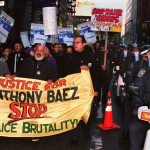
Iris, left, and Ramon Baez, second from left, the parents of Anthony Baez, carry a banner as they march with at least 3,000 protesters down Broadway to New York’s City Hall to protest police brutality, Thursday, Oct. 22, 1998. NEW YORK — The similarities are striking. Both Anthony Baez and Eric Garner, in their final moments, were put into chokeholds by officers from the New York City Police Department. Both of the cops involved were white, while Baez and Garner were minorities and unarmed. Both men’s deaths set off protests across the city, their names added to a long list of black and Latino men who have died in altercations with police. But Francis Livoti, the officer who…
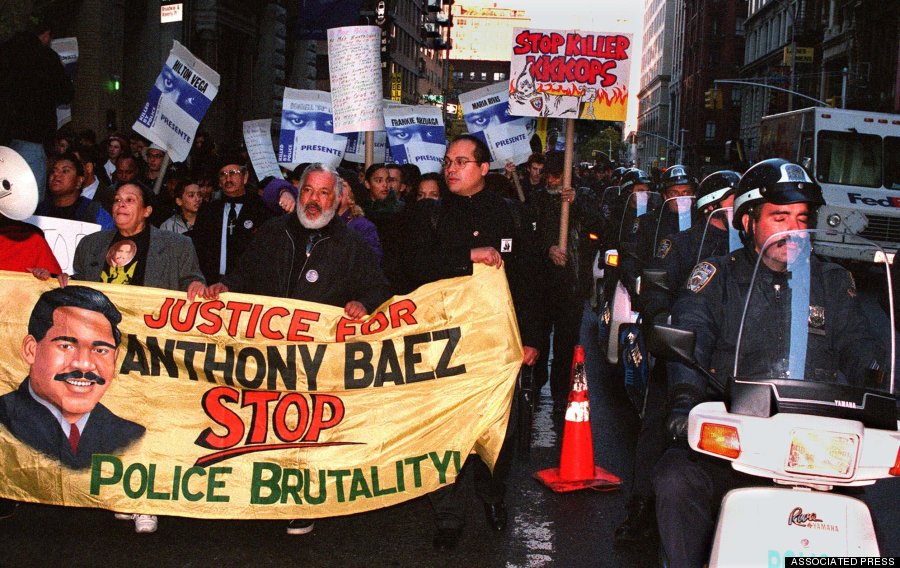
NEW YORK — The similarities are striking.
Both Anthony Baez and Eric Garner, in their final moments, were put into chokeholds by officers from the New York City Police Department. Both of the cops involved were white, while Baez and Garner were minorities and unarmed. Both men’s deaths set off protests across the city, their names added to a long list of black and Latino men who have died in altercations with police.
But Francis Livoti, the officer who killed Baez, ultimately spent seven years in a federal prison. In December, a Staten Island grand jury decided not to indict NYPD Officer Daniel Pantaleo in Garner’s death.
That grand jury decision precipitated several tense weeks in New York. Protesters — organizing around the hashtag #BlackLivesMatter — routinely took to the streets.
Mayor Bill de Blasio, responding to the grand jury decision, recalled how he and his wife had to “literally train” their biracial son, “as families have all over this city for decades,” in how to “take special care in any encounter he has with the police officers who are there to protect him.”
Police unions took umbrage with the mayor’s sentiment. Then, a lone gunman shot and killed two officers inside their patrol car in Brooklyn, further increasing tension between the mayor and the force. After the officers’ deaths, one police union president, Patrick Lynch, said de Blasio had “blood on his hands.”
At both of the officers’ funerals, policemen turned their backs as the mayor spoke.
Meanwhile, the NYPD inspector general recently released a report showing that cops are rarely, if ever, disciplined for using the banned chokehold maneuver.
This Thursday, a judge will hear arguments around whether the grand jury records in Eric Garner’s death should be released to the public. As the hearing — and the potential release of the grand jury documents — will surely reignite the debate over whether Pantaleo should have been indicted, it also pulls into focus the prospect of the federal government stepping in and pressing civil rights charges against Pantaleo.
Amid all the political turmoil and fallout since Garner’s death, his family, as well as many activists, have remained vigilant in demanding that the federal government take action — even as news broke that federal charges are not expected against Darren Wilson, the police officer in Ferguson, Missouri, who fatally shot Michael Brown, another case that triggered outrage across the country.
The Department of Justice did announce in December that it is investigating Garner’s death. However, Cynthia Davis, a spokeswoman for the Garner family, said “that’s not good enough.”
“We’re still seeking justice,” she told HuffPost. “They need to take the case. They need to do more than just look into it.”
“That’s why we’re out there,” she continued. “That’s exactly why we’re protesting. We’re asking for the federal government to step in and take control of this case.”
But could Pantaleo face the same fate as Livoti — the officer who put Baez into a chokehold 20 years ago? Experts say the answer to that question could prove disappointing for the Garner family, who in January marked the six-month anniversary of his death.
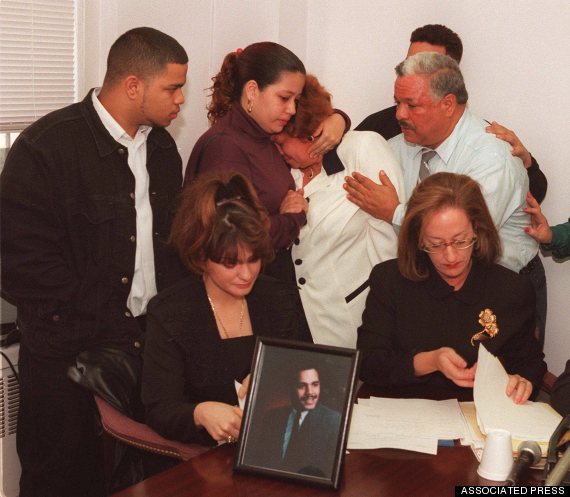
It all started with a late-night family game of touch football.
On Dec. 22, 1994, Anthony Ramon Baez, a 29-year-old Latino man, and his three brothers were playing in the street at 1:30 a.m. outside their parents’ South Bronx home. Meanwhile, two NYPD patrol cars with four officers inside were parked nearby.
After two errant football passes struck the patrol cars, Livoti got out of his vehicle and yelled and cursed at the Baez brothers, ordering them to go home, according to an appeals court’s summary of that night’s events. The brothers briefly consulted with one another and decided they’d continue to play.
Before they could resume their game, Livoti stepped out of the patrol car and again yelled and cursed at the brothers, this time challenging them to a fight. When Anthony’s brother David openly defied Livoti’s demand to go home, Livoti said that David would be spending Christmas in jail on Rikers Island. He put David in handcuffs, before putting him in the back seat of his patrol car.
Livoti then turned his attention to Anthony, who’d been protesting his brother’s arrest. Pushing Anthony over onto the sidewalk, Livoti attempted to place him in handcuffs as well. Anthony resisted, holding his hands against his chest. Meanwhile, four other police officers had arrived at the scene.
That’s when Livoti wrapped the crook of his arm around Anthony’s neck, other officers testified during a trial for Livoti. It was a chokehold, a sometimes deadly maneuver that had been banned by the police department a year prior.
Anthony’s father had come out of the house at this point, and pleaded with Livoti to let his son go, to stop choking him. Livoti didn’t let go for a whole minute, according to medical testimony cited by the appeals court. Eventually, Anthony became limp and motionless.
Livoti and other officers transported Anthony to the hospital, where he was pronounced dead. The New York City medical examiner later ruled Baez’s death a homicide. The autopsy report said that Baez died from asphyxiation caused by “compression of his neck and chest,” as well as acute asthma.
It was not the first time that Livoti had been accused of using unnecessary force. He was already the subject of nine police brutality complaints before his altercation with the Baez brothers.
“When my husband said, ‘Let go of my son,’ [Livoti] should’ve let go,” Anthony’s mother, Iris Baez, told The Huffington Post recently. Just a few days before Christmas, Iris marked the 20th anniversary of her son’s death with family, friends and supporters at a candlelight vigil in the Bronx, on the very street — since renamed Anthony Baez Place — where her son was killed.
“I don’t think [Officer Livoti] murdered my son — he murdered my whole family,” she told HuffPost.
She added that the grand jury’s decision not to indict Pantaleo in Eric Garner’s chokehold death left her reeling. “My heart cries with the [Garner family],” she said.
“Every time you see me, you want to mess with me,” 43-year-old Eric Garner told officers who were trying to arrest him for selling untaxed “loosie” cigarettes. “I’m tired of it. This stops today!”
In a video from July 17 showing the confrontation between Garner and police, officers approach, and Garner puts his hands up. “Don’t touch me,” he says. The video then shows Officer Daniel Pantaleo wrapping his arm around Garner’s neck and bringing him to the ground. Garner, who like Baez, suffered from asthma, utters the words “I can’t breathe” 11 times times before his body goes limp.
Pantaleo is the subject of three federal lawsuits over his policing. Two young black men — 22-year-old Kenneth Smith and 19-year-old Rylawn Walker — recently filed separate lawsuits alleging Pantaleo and other officers falsely arrested and imprisoned them on trumped up marijuana charges. In court documents, Walker alleged that Pantaleo also “misrepresented facts in the police reports and other documents.”
Two other men — 46-year-old Darren Collins and 43-year-old Tommy Rice — allege in another lawsuit that Pantaleo strip-searched them in public, and slapped their testicles during the search. The pair settled the lawsuit earlier this year for $30,000.
Unlike Pantaleo, a New York grand jury indicted Livoti on charges of criminally negligent homicide. But in 1996, a New York state judge acquitted him.
“It was like a slap in the face,” Baez said of the judge’s decision, adding that it was like her son was being “murdered all over again.”
After the acquittal, the United States Department of Justice announced it would investigate Baez’s death to determine whether Livoti had violated his civil rights. Less than two years later, the DOJ brought civil rights charges against the officer and ultimately won a conviction, sending Livoti to prison for seven years.
Livoti was released in 2005 from the Federal Correctional Complex in Butner, North Carolina. Now a professional Frank Sinatra impersonator in New York who goes by the name “Frankie Sands,” he declined to comment for this story.
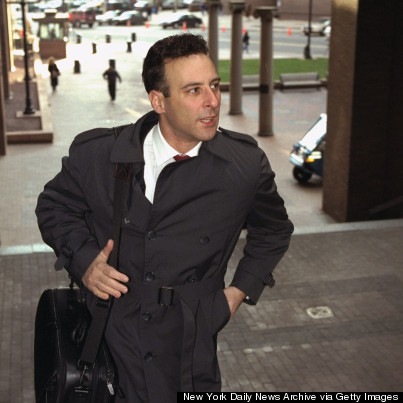
hearing on the death of Anthony Baez. (Photo by Mike Albans/NY Daily News Archive via Getty Images)
T“This is not a murder case,” one of the prosecuting U.S. attorneys told the jury at the beginning of Livoti’s federal trial. This was a civil rights case.
Homicides, with few exceptions, are always state, not federal, crimes. And Livoti had already been acquitted of negligent homicide in a state court.
For federal prosecutors to send Livoti to prison, they didn’t have to prove that, beyond a reasonable doubt, he had committed a negligent homicide. They had to prove that Livoti violated Baez’s civil rights. In order to do that, they had to show three things.
First, they had to prove Livoti deprived Baez of a right secured or protected under the Constitution. In the case against Livoti, the prosecutors argued that Livoti had deprived Baez of his Fourth Amendment right to be free from excessive force.
“There was an issue to a degree whether Mr. Livoti even had a right to make an arrest,” United States Assistant Attorney Andrew Dember, who was one of the prosecutors in the case, told HuffPost.
Dember said the prosecution argued in court that Livoti had attempted to arrest Baez even though Baez had broken no laws. Because the arrest was unjustified to begin with, any use of force was considered “excessive,” they argued.
Second, Dember and his fellow prosecutors had to prove that Livoti deprived Baez of his civil rights while “under the color of law.” In other words, they had to prove that Livoti was acting in his capacity as a law enforcement official. This was easy to prove, as Livoti had confronted the Baez brothers as a uniformed police officer.
And third, Dember had to prove that Livoti’s conduct was “willful.” It’s this third element, Dember said, that “makes these cases difficult.”
It would not be enough to prove that Livoti had acted negligently. Rather, to establish willfulness, the prosecution had to prove that Livoti acted in bad faith — that he knew, or should have known, that what he was doing was wrong.
“One of the important ways we showed willfulness was the fact at that time, the use of the kind of the chokehold that was put on Anthony Baez was explicitly prohibited,” Dember said. “We put into evidence the actual [NYPD] policy itself, as well as evidence that Livoti had attended training where that policy was taught to police officers.”
It was the prosecution’s argument, Dember added, that Livoti was aware of the ban, but “nevertheless disregarded that knowledge.”
Three of Livoti’s fellow police officers — who later faced perjury charges — testified that he never actually used a chokehold. Two other officers, however, as well as the Baez brothers and their father, testified that Livoti had indeed used the maneuver.
But another, perhaps more crucial part of proving willfulness, Dember said, were the “circumstances in the way Mr. Livoti came out of the patrol car.” That Livoti appeared to act out of anger and that he instigated an argument with the Baez brothers when they had done nothing wrong, Dember said, showed willfulness.
The trial lasted two weeks in June of 1998. When it came time for closing arguments, Dember attacked Bronx District Attorney Robert Johnson for failing to get a state-level conviction against Livoti in the first place. He called the DA’s office “ridiculous” and “incredibly unprofessional.”
After all, Johnson only had to prove negligence to win a conviction against Livoti — a lower standard than in federal court, where Dember and his colleagues had to prove willfulness and intent.
“There are differences in Federal and State statutes and rules of evidence that, perhaps at that moment, Mr. Dember had forgotten,” Johnson, who is still the Bronx DA, said in an emailed response to Dember’s comments. “This office tried the case in State Supreme Court with all available evidence. It was, ultimately, the judge’s decision to acquit [non jury trial].”
The Daily News reported that Iris Baez, dressed in all black, cried and smiled at the same time while talking to reporters outside the courthouse the day the federal jury found Livoti guilty. “This family had to go through four years of, really, a nightmare,” she said.
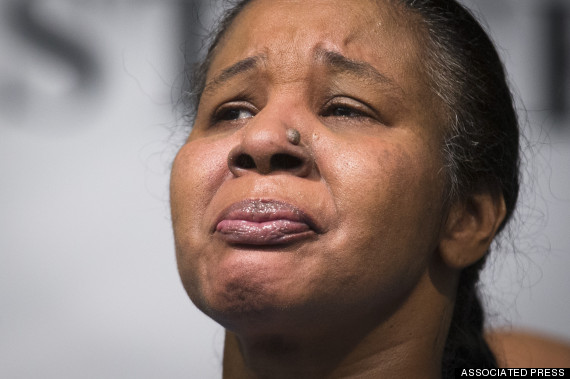
in New York on Wednesday, Dec. 3, 2014, after a grand jury’s decision not to indict a New York
police officer involved in her husband’s death. (AP Photo/John Minchillo)
If the DOJ were to pursue charges against Pantaleo, legal experts told HuffPost the department would likely use a similar strategy to the one it used against Livoti.
But according to the experts, the case against Pantaleo is not as clear-cut as the case against Livoti — even with the video evidence in Garner’s death, which some observers have said should bolster the case against him.
The DOJ has had a tough time coming up with a precise definition of the “excessive” in “excessive force.” It tried back in the 1990s, completing a comprehensive study of violent interactions between police and civilians, but concluded in a report that “the lack of accepted definitions of use of force and excessive force will remain a fact of life.”
In other words, the DOJ didn’t think there could ever be a firm metric for what’s “excessive” and what’s not. It’s always an ad hoc determination.
Dember said he was able to convince a jury that Livoti’s treatment of Baez was excessive because Baez had done nothing wrong, and had committed no crimes.
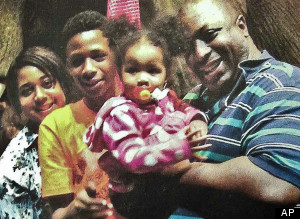
(AP/National Action Network)
But in Garner’s case, police were arresting him because he had allegedly committed a crime — albeit the petty crime of selling untaxed “loosie” cigarettes. Because Garner was under arrest, and resisted that arrest, Pantaleo could argue that he was required to use force under the circumstances.
The lawyer for the Garner family, Jonathan Moore, has argued that Pantaleo and his fellow officers should have just issued Garner a court summons and walked away.
But Eugene O’Donnell — a former NYPD officer and former New York prosecutor who now teaches at the John Jay College of Criminal Justice — said that selling untaxed cigarettes is “an unclassified misdemeanor” and an “arrestable offense.”
“This was not a rogue operation,” O’Donnell said, pointing to other times NYPD officers have arrested people selling loosies.
According to James Jacobs, a professor of criminal law and criminal procedure at New York University Law School, one of the crucial questions that would be raised in a federal trial is: “Would a reasonable police officer in this same situation do what [Pantaleo] did?”
The answer to that question, according to O’Donnell, is yes.
But what about what type of force Pantaleo decided to use? Chokeholds, after all, are banned by NYPD guidelines. In order to get a conviction, Jacobs said, the prosecutors would have to prove Pantaleo “used a [chokehold] intentionally, that Pantaleo had other alternatives, that he could think about it for a while, and that he deliberately chose this unreasonable means of making an arrest.”
For now, pending the internal investigation, Pantaleo is stripped of his gun and badge and is suspended with pay. His lawyer, Stuart London, is the same attorney who defended Livoti in 1998 in his federal case. London declined to discuss Pantaleo’s case with HuffPost.
In an interview with CNN, London said he observed NYPD Internal Affairs questioning Pantaleo over Garner’s death.
“[Pantaleo] indicated he never used a chokehold,” London told CNN. “He used a takedown technique he was taught in the academy. He said he never exerted any pressure on the windpipe and never intended to injure Mr. Garner.”
Aside from the police unions, very few people have claimed that the maneuver wasn’t a chokehold. New York City Mayor Bill de Blasio said in July that it “looked like a chokehold” to him. And the New York City medical examiner stated in Garner’s autopsy that “compression of neck (chokehold), compression of chest and prone positioning during physical restraint by police,” caused Garner’s death.
How A Chokehold Works

Sources: Marine Corps Martial Arts Program; Forensic Pathology, Second Edition
Click here for a larger version of this graphic.
NYPD guidelines state that “Members of the New York City Police Department will NOT use chokeholds. A chokehold shall include, but is not limited to, any pressure to the throat or windpipe, which may prevent or hinder breathing or reduce intake of air.”
While chokeholds are banned by the NYPD — meaning officers can be disciplined internally for using them — they are not against the law. That means officers can’t actually be charged with a crime for using one. (There is, however, a bill before the City Council — which Mayor de Blasio and NYPD Commissioner William Bratton oppose — that would criminalize the use of chokeholds.)
There were over 1,000 complaints regarding the NYPD’s use of chokeholds between 2009 and 2013, according to New York City’s Civilian Complaint Review Board. But only nine of those complaints were substantiated, and a January report from NYPD Inspector General Philip Eure found that even in those substantiated cases, the NYPD routinely refused to discipline the officers involved.
Grand jury proceedings are secret, so we don’t know what Pantaleo told jurors before they chose not to indict him. He could have argued that he used what’s called a “lateral vascular neck restraint,” which restricts blood flow to the brain but does not put pressure on the throat or windpipe. LVNRs can still be deadly.
Medical testimony in Livoti’s case, on the other hand, said Baez had died due to a chokehold that lasted one minute and rendered him unconscious. The medical examiner also used a word in Baez’s autopsy that’s missing from Garner’s: “asphyxiation.” In other words, Baez died because of pressure to his windpipe — which is explicitly banned by NYPD guidelines. In Garner’s case, Pantaleo could have possibly been acting within NYPD guidelines, as London said Pantaleo argued.
Determining whether Pantaleo used a “chokehold” would be up to a federal jury, if it even gets that far.
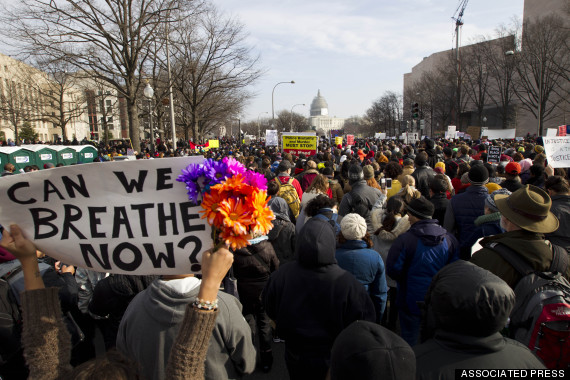
“Justice for All” march. (AP Photo/Jose Luis Magana)
On Dec. 13, the Rev. Al Sharpton led 50,000 protesters through the streets of Washington, D.C., demanding that the federal government intervene in prosecutions of police officers facing criminal charges.
Sharpton has previously said that local and state prosecutors are “conflicted” when they have to prosecute officers because they often work so closely with police.
It’s common for the federal government to investigate cases of alleged police brutality. As in Livoti’s case, the DOJ has traditionally acted as a backstop for when state prosecutors fail to bring charges or win convictions against police.
The DOJ is also currently investigating the case of Ramarley Graham, another unarmed black man killed by a while police officer in the Bronx in 2012.
U.S. Attorney Loretta Lynch, whose district includes Staten Island, said in a December statement that her office’s investigation into Garner’s death “will be fair and thorough, and it will be conducted as expeditiously as possible.” It’s not yet clear when charges will be brought, if they are at all.
But while investigations into these cases are common, bringing back a federal indictment or conviction against the officers is not.
Lynch — who is currently facing a confirmation hearing in the U.S Senate to be President Barack Obama’s next attorney general — has experience prosecuting cops for civil rights violations. She won a conviction against NYPD Officer Justin Volpe in 1999 for brutalizing and sodomizing a Haitian immigrant named Abner Louima. Volpe was sentenced to 30 years in prison.
But according to Newsday, a look at the last five years of Lynch’s tenure as the U.S attorney for the Eastern District of New York — which covers Brooklyn, Queens, Staten Island and Long Island — shows that her office more often than not declines to bring federal charges in cases involving the police.
Newsday reported in December that Lynch “declined to bring cases when police were accused of criminal violations of federal civil rights 14 out of 16 times,” according to DOJ data provided by the nonprofit Transactional Records Access Clearinghouse.
“It’s a harder job for the federal government” to prosecute police cases, Jacobs, the NYU professor, emphasized to HuffPost, because the DOJ has to prove intent, not negligence.
The political fallout in New York since Garner’s death has been large. The New York Civil Liberties Union, the Legal Aid Society, Public Advocate Letitia James and the New York Post have all petitioned to have the Eric Garner grand jury records released, arguing that there’s a compelling public interest in how the grand jury was conducted. Oral arguments are set for Thursday in the case, although it’s unclear when the judge will rule.
New York Gov. Andrew Cuomo, meanwhile, is considering having special prosecutors handle all cases involving the police. He announced in his State of the State speech last month that he’s considering requiring the state to review all police brutality cases in which a grand jury fails to bring back an indictment.
The potential release of the grand jury records, and Cuomo’s potential reforms, are welcome news to the Garner family. But for now, they’re in a holding pattern, routinely holding protests and vigils twice a week — chanting “No justice, no peace!” — and waiting to hear from the DOJ.
“We here for [the Garner family],” Iris Baez, Anthony Baez’ mother, told HuffPost. “When all this is finished, we’ll be here for them, just like we’re here for all others.”
Read article here –




















